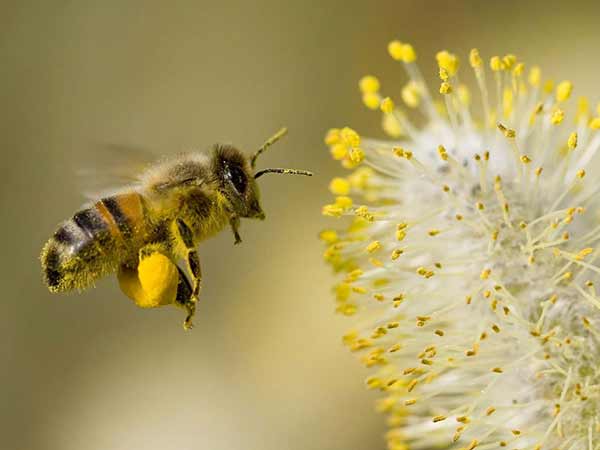Home » natural health »
BEE PRODUCTS: Pollen, propolis and royal jelly
When you learned about the birds and the bees, were you told about the special link between nutrient supplementation and the reproductive system? This is essentially what bees do, helping to implement nature’s master plan of concentrating nutrients in the reproductive systems of plants and animals. We’re more familiar with germinative foods like nuts, seeds, roe and egg yolks, and they are indeed among the best food sources of nutrients. But by not taking advantage of the three bee products – pollen, propolis and royal jelly – we’re depriving ourselves of the best of the best.
Bee Pollen
Between the flower and the hive, pollen becomes a complete source of protein, vitamins, minerals and fatty acids, nourishing enough to sustain lab animals’ lives over many generations. It’s an especially good source of rutin, a bioflavonoid that helps strengthen capillaries and treat glaucoma. Some research also suggests that bee pollen contains natural antibiotic compounds that may ward off salmonella and other harmful bacteria.
The most exciting application, however, has been the treatment of benign enlargement of the prostate, prostatitis and other disorders of the gland. An extract from flower pollen has been used successfully in Europe for thirty years. And bee pollen could find itself alongside saw palmetto and pygeum for relieving the symptoms caused by prostate disease. We’re not sure yet what component of bee pollen possesses the therapeutic qualities. The nutrients, while plentiful, don’t appear in sufficiently high amounts, so a unique compound as yet unidentified may in fact be responsible.
Bee Propolis
Although considered a bee product, propolis is really a plant substance modified by bees. Flavonoids provide most of its healing activity, so think of it as a potent flavonoid extract prepared for us by our buzzing friends.
Bees use this sticky, resinous substance structurally, as an aid in constructing hives and plugging up holes. We can take advantage of its microbial protection, too. Research has documented its worth against parasites, fungal infections and viruses, especially herpes and the flu. Its antibacterial abilities are of significant value against upper-respiratory infections. Probably because of the flavonoids, it’s also an antioxidant.
Topically, propolis helps wounds heal; on the gums, it could be particularly useful for fighting periodontal disease. Applying it directly on cancerous cells, some animal studies have found, inhibited the malignancy and decreased the size of tumours by as much as 74 per cent. When ingested, it can help heal ulcers. Although there’s a paucity of clinical research on people, the initial work is encouraging.
Royal Jelly
With her astounding size, longevity and reproductive assets, the queen bee doesn’t rule by accident. She reigns over her parade of worker bees because they feed her nothing but royal jelly. Whether in the world of apians or Homo sapiens, this highly concentrated superfood is indeed fit for a queen.
Royal jelly has become a popular supplement for boosting energy, strengthening the adrenal glands and supporting the immune system. Of its many health-promoting advantages, the most important may be the ability to increase our nutrient a orption, allowing our bodies to get the most out of the food we eat. Its also a concentrated source of nutrients, including minerals, В vitamins and compounds unavailable anywhere else. For example, scientists have identified two unique antibacterial substances that reside within it: a protein called royalisin and a fatty acid dubbed 10-HDA. Other, perhaps stronger, bacterial killers may await our discovery, because the whole royal jelly displays ten times the disinfectant power of either isolated compound. I think it’s another testament to the therapeutic whole being greater than the sum of its nutrient parts.
Included among the chemical components of royal jelly are precursors to human hormones, which validates the substance’s traditional use as a fertility-enhancing food. It also works somewhat like insulin in the body. Other research has affirmed its ability to lower total cholesterol and improve the LDL-HDL ratio. In addition, when injected into the body, according to animal experiments, royal jelly opposes cancer. Lab mice with cancer remained alive and healthy for more than twelve months after receiving shots of either 10-HDA or whole, unprocessed royal jelly. Mice that didn’t receive the supplement died within twelve days.






0 Comments
You can be the first one to leave a comment.